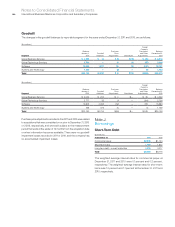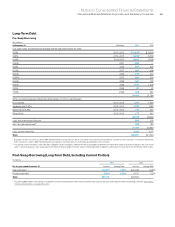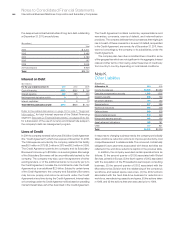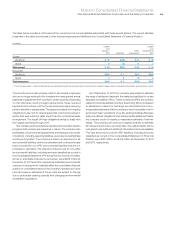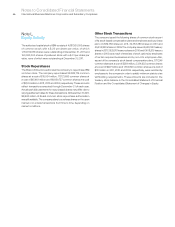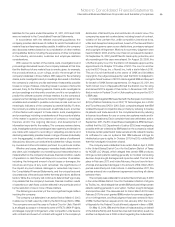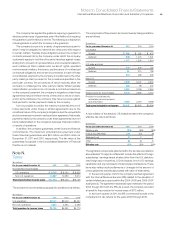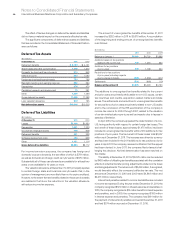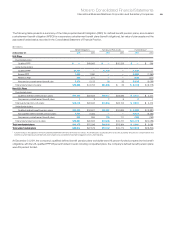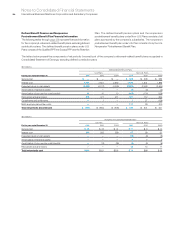IBM 2011 Annual Report Download - page 116
Download and view the complete annual report
Please find page 116 of the 2011 IBM annual report below. You can navigate through the pages in the report by either clicking on the pages listed below, or by using the keyword search tool below to find specific information within the annual report.Notes to Consolidated Financial Statements
International Business Machines Corporation and Subsidiary Companies114
alleged in the SEC’s complaint, (ii) prejudgment interest on that
amount of $2.7 million, and (iii) a civil penalty of $2 million. The
settlement is subject to court approval.
The company is a defendant in numerous actions filed after
January 1, 2008 in the Supreme Court for the State of New York,
county of Broome, on behalf of hundreds of plaintiffs. The complaints
allege numerous and different causes of action, including for negligence
and recklessness, private nuisance and trespass. Plaintiffs in these
cases seek medical monitoring and claim damages in unspecified
amounts for a variety of personal injuries and property damages
allegedly arising out of the presence of groundwater contamination
and vapor intrusion of groundwater contaminants into certain structures
in which plaintiffs reside or resided, or conducted business, allegedly
resulting from the release of chemicals into the environment by
the company at its former manufacturing and development facility
in Endicott. These complaints also seek punitive damages in an
unspecified amount. The first trial in these cases is scheduled to
begin in October 2012.
The company is party to, or otherwise involved in, proceedings
brought by U.S. federal or state environmental agencies under the
Comprehensive Environmental Response, Compensation and Liability
Act (CERCLA), known as “Superfund,” or laws similar to CERCLA.
Such statutes require potentially responsible parties to participate
in remediation activities regardless of fault or ownership of sites. The
company is also conducting environmental investigations, assessments
or remediations at or in the vicinity of several current or former
operating sites globally pursuant to permits, administrative orders
or agreements with country, state or local environmental agencies,
and is involved in lawsuits and claims concerning certain current or
former operating sites.
The company is also subject to ongoing tax examinations and
governmental assessments in various jurisdictions. Along with many
other U.S. companies doing business in Brazil, the company is
involved in various challenges with Brazilian authorities regarding
non-income tax assessments and non-income tax litigation matters.
These matters include claims for taxes on the importation of computer
software. In November 2008, the company won a significant case in
the Superior Chamber of the federal administrative tax court in Brazil,
and in late July 2009, the company received written confirmation
regarding this decision. The total potential amount related to the
remaining matters for all applicable years is approximately $600 million.
The company believes it will prevail on these matters and that this
amount is not a meaningful indicator of liability.
Commitments
The company’s extended lines of credit to third-party entities
include unused amounts of $4,040 million and $3,415 million at
December 31, 2011 and 2010, respectively. A portion of these amounts
was available to the company’s business partners to support their
working capital needs. In addition, the company has committed to
provide future financing to its clients in connection with client purchase
agreements for approximately $2,567 million and $2,825 million at
December 31, 2011 and 2010, respectively.
of social service program processing in Indiana. The State terminated
the contract, claiming that IBM was in breach, and the State is seeking
damages. IBM believes the State’s claims against it are without merit
and is seeking payment of termination amounts specified in the
contract. Trial began in late February 2012 in Marion County, Indiana
Superior Court.
The company was named as a co-defendant in numerous
purported class actions filed on and after March 18, 2011 in federal
and state courts in California in connection with an information
technology outsourcing agreement between Health Net, Inc. and
IBM. The matters were consolidated in the United States District
Court for the Eastern District of California, and plaintiffs filed a
consolidated complaint on July 15, 2011. The consolidated complaint
alleges that the company violated the California Confidentiality of
Medical Information Act in connection with hard drives that are
unaccounted for at one of Health Net’s data centers in California;
plaintiffs have been notified by Health Net that certain of their personal
information is believed to be contained on those hard drives. Plaintiffs
seek damages, as well as injunctive and declaratory relief. IBM has
also received a request for information regarding this matter from the
California Attorney General. On January 12, 2012, the court granted
IBM’s motion to dismiss the complaint for lack of standing, and on
February 22, the case against IBM was dismissed.
IBM United Kingdom Limited (IBM UK) initiated legal proceedings
in May 2010 before the High Court in London against the IBM UK
Pensions Trust (the UK Trust) and two representative beneficiaries
of the UK Trust membership. IBM UK is seeking a declaration that
it acted lawfully both in notifying the Trustee of the UK Trust that it
was closing its UK defined benefit plans to future accruals for most
participants and in implementing the company’s new retirement policy.
The trial in the High Court is scheduled to begin in February 2013.
In addition, IBM UK is a defendant in approximately 275 individual
actions brought since early 2010 by participants of the defined benefits
plans who left IBM UK. These actions, which allege constructive
dismissal and age discrimination, are pending before the Employment
Tribunal in Southampton UK and are currently stayed pending
resolution of the above-referenced High Court proceedings. In a
separate but related proceeding, in March 2011, the Trustee of the
IBM UK Trust was granted leave to initiate a claim before the High
Court in London against IBM UK and one member of the UK Trust
membership, seeking an order modifying certain documents and
terms relating to retirement provisions in IBM UK’s largest defined
benefit plan dating back to 1983. The trial of these proceedings is
scheduled to begin in May 2012.
In March 2011, the company announced that it has agreed to
settle a civil enforcement action with the SEC relating to activities
by employees of IBM Korea, LG IBM, IBM (China) Investment Company
Limited and IBM Global Services (China) Co., Ltd., during the period
from 1998 through 2009, allegedly in violation of the Foreign Corrupt
Practices Act of 1977. As part of the settlement, IBM has consented
to the entry of a judgment relating to the books and records and
internal control provisions of the securities laws. IBM has also
agreed to pay a total of $10 million, categorized by the SEC as follows:
(i) $5.3 million, representing profits gained as a result of the conduct




